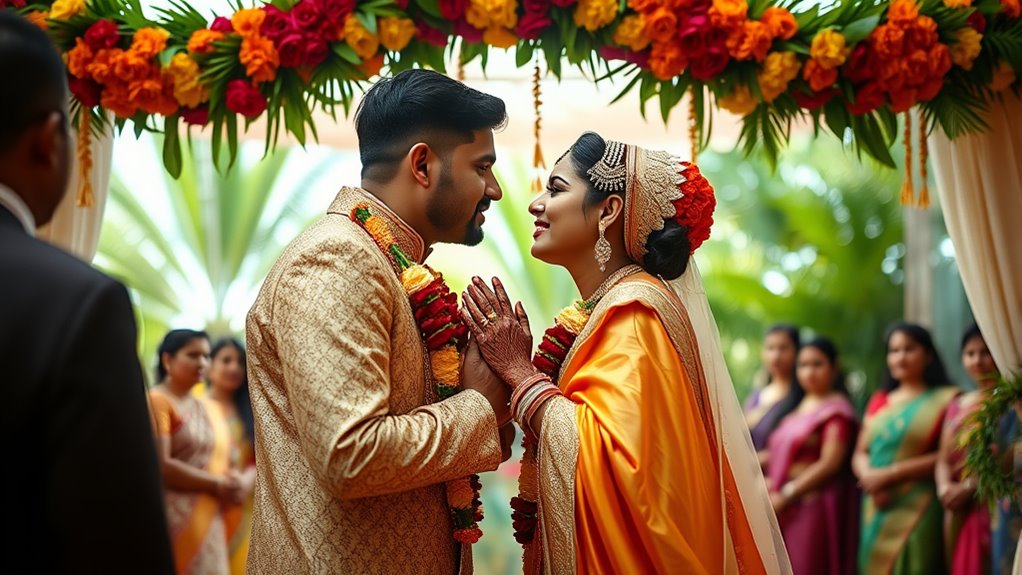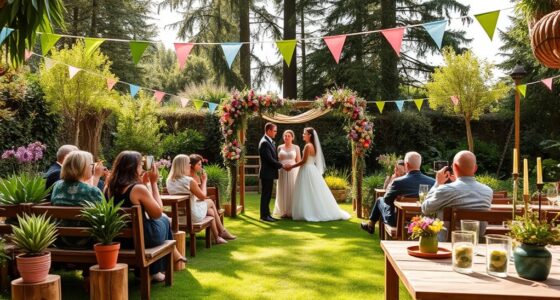Across continents, wedding kisses symbolize love, unity, and cultural tradition, though customs vary widely. In Western countries, couples often share a passionate kiss after vows, while Asian traditions may favor more reserved gestures emphasizing respect. Latin American and Southern European ceremonies tend to be more expressive and passionate. Modern influences allow for personalized touches, blending tradition with contemporary styles. To discover how these rituals continue to evolve and influence modern weddings worldwide, keep exploring the diverse cultural practices.
Key Takeaways
- Wedding kisses symbolize unity, love, and the merging of families across diverse cultures worldwide.
- Regional customs vary from passionate Latin American kisses to reserved Asian gestures emphasizing respect.
- Modern adaptations include personalized, playful, or choreographed kisses reflecting individual or cultural preferences.
- Changes in social norms influence the style and significance of wedding kisses, blending tradition with contemporary values.
- Despite variations, wedding kisses continue to serve as meaningful gestures of love, commitment, and cultural symbolism globally.

Kissing rituals in wedding ceremonies vary widely across cultures, reflecting diverse traditions and beliefs about love and union. As you observe these customs, you’ll notice that each kiss holds deeper meaning, often rooted in cultural symbolism that signifies more than just affection. In many traditions, a kiss marks the official sealing of vows, symbolizing unity, commitment, and the merging of two families. These gestures are often embedded with centuries-old significance, serving as tangible expressions of love and social acceptance. However, modern adaptations have influenced how these rituals are performed, blending tradition with contemporary notions of romance and personal expression. For example, some cultures have simplified or even replaced traditional kisses to accommodate changing social norms or personal comfort levels, yet they still aim to preserve the essence of union and commitment. Additionally, the choice of how to perform the kiss can reflect the evolving cultural norms and personal preferences of the couple.
Kissing rituals symbolize unity, commitment, and love, blending tradition with modern adaptation across cultures worldwide.
In Western wedding ceremonies, the kiss is almost universally recognized as the highlight following the vows. It’s often seen as a public declaration of love, and its style can vary depending on personal preferences or modern influences. Today, many couples choose to customize their kissing moments, incorporating playful, tender, or symbolic gestures that reflect their personalities or relationship. This flexibility demonstrates how modern adaptations allow for more personal expression without losing the core symbolism of the act. In some cases, couples might incorporate a series of quick kisses or a more elaborate, choreographed embrace, turning a simple tradition into a memorable spectacle that resonates with their unique bond.
Across different regions, the significance of the kiss can differ dramatically. In parts of Asia, for instance, physical affection during weddings might be more reserved, with cultural symbolism emphasizing harmony and respect rather than overt displays of passion. Conversely, in Latin America or Southern Europe, passionate kisses are often celebrated openly, embodying the exuberance of love and familial warmth. Despite these differences, the evolving nature of wedding rituals reflects a broader trend: adapting age-old customs to fit modern values and lifestyles. Whether it’s a traditional peck or an elaborate, symbolic kiss, the core idea remains the same—celebrating love’s bond and marking a new chapter.
As you explore wedding traditions across the globe, you’ll see how these rituals serve as a bridge between history and modernity. They honor cultural symbolism while embracing contemporary adaptations, ensuring that the act of a kiss continues to be a meaningful, personal gesture. It’s a reminder that, regardless of how it’s performed, a wedding kiss is ultimately about expressing love, unity, and commitment in a way that resonates with both tradition and your own unique story.
Frequently Asked Questions
How Do Cultural Differences Influence Wedding Kissing Customs?
Cultural differences greatly influence wedding kissing customs, shaping how couples express love. You’ll notice that in some cultures, kissing symbolizes purity and unity, while in others, it’s a sign of passion. These cultural variations reflect traditions and societal values, so your approach to wedding kisses might change based on your background. Embracing these differences helps you understand the deeper symbolism behind each custom, making your wedding celebration more meaningful and respectful of diverse traditions.
Are There Any Legal Restrictions on Public Wedding Kisses Worldwide?
Like Romeo and Juliet’s forbidden kiss, public wedding kisses face legal boundaries worldwide. You might find laws vary, with some places emphasizing public decency and others more lenient. While many countries tolerate romantic displays, certain regions restrict or penalize public intimacy to maintain social order. So, before sharing that passionate kiss, check local laws—because what’s romantic in one country could be illegal in another.
What Are the Symbolic Meanings Behind Wedding Kisses in Different Cultures?
You might wonder about the symbolic meanings behind wedding kisses in different cultures. These symbolic gestures serve as powerful cultural expressions, representing love, unity, and commitment. In some traditions, a kiss seals the bond and signifies trust, while in others, it symbolizes the couple’s connection and future together. Recognizing these cultural expressions helps you appreciate the rich diversity and significance of wedding rituals worldwide.
How Have Modern Influences Changed Traditional Wedding Kissing Rituals?
You’ve noticed that modern influences like social media have transformed traditional wedding kissing rituals. Evolutionary trends now encourage couples to personalize their vows and moments, often sharing these on platforms to celebrate their love publicly. This shift makes the kiss more spontaneous and expressive, moving away from stiff customs. Social media amplifies these moments, creating a broader cultural impact and inspiring couples worldwide to adapt their rituals creatively and meaningfully.
Are There Specific Wedding Kissing Customs for Same-Sex Marriages?
Like a dance with unique steps, same-sex wedding traditions often include special kissing customs. You’ll find ritual variations that celebrate love’s diversity, from intimate pecks to elaborate gestures. Many cultures embrace these customs, emphasizing equality and connection. These rituals highlight love’s universality, allowing couples to express their bond in meaningful ways. So, whether traditional or modern, same-sex traditions enrich the beautiful tapestry of wedding ceremonies worldwide.
Conclusion
As you explore wedding kisses across continents, you realize these rituals aren’t just traditions—they’re universal symbols of love connecting souls. Coincidentally, no matter where you look, a simple kiss marks the beginning of a new chapter, reminding us all that love’s language transcends borders. So, next time you share a kiss, remember it’s more than a gesture; it’s a timeless bond that unites hearts across the world.










